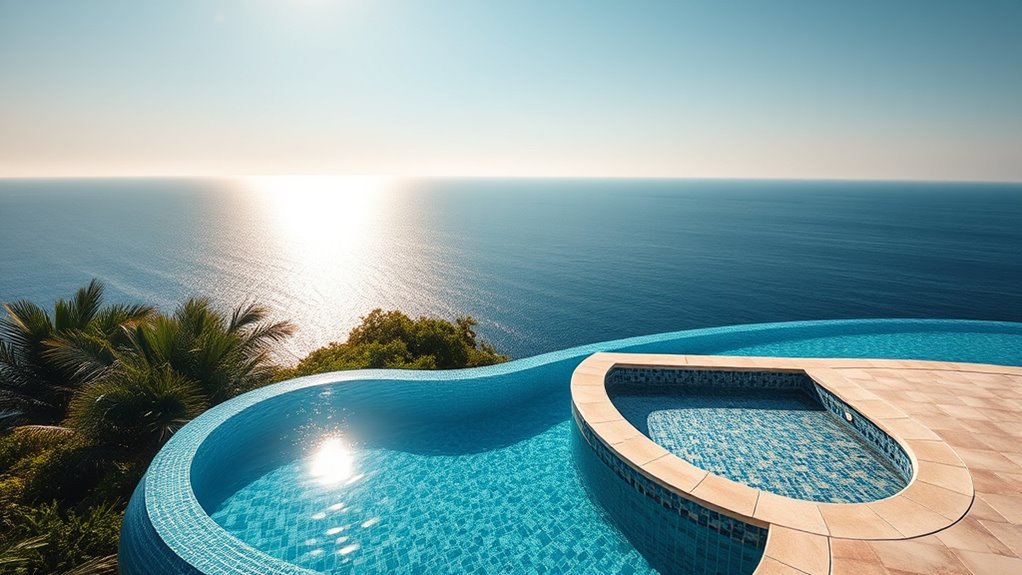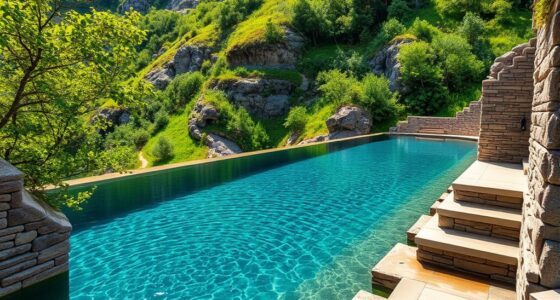When choosing between an infinity pool and a plunge pool, consider your space, budget, and desired vibe. Infinity pools create a sleek, luxurious look perfect for scenic views but require more space and higher costs upfront and for maintenance. Plunge pools are smaller, more affordable, and fit well into tighter yards, offering a cozy, relaxing atmosphere. Keep exploring to discover which option best matches your outdoor lifestyle and design dreams.
Key Takeaways
- Infinity pools require larger space, unobstructed views, and have higher installation and maintenance costs.
- Plunge pools are compact, suitable for smaller yards, and generally involve lower upfront and ongoing expenses.
- Infinity pools offer a luxurious, modern vibe emphasizing openness and scenic integration; plunge pools provide a cozy, practical atmosphere.
- Infinity pools are ideal for scenic landscapes and large outdoor areas; plunge pools fit well in tight or landscaped spaces.
- The choice depends on budget, available space, desired aesthetic, and the intended use for relaxation or exercise.
Comparing the Visual Impact and Design Aesthetics
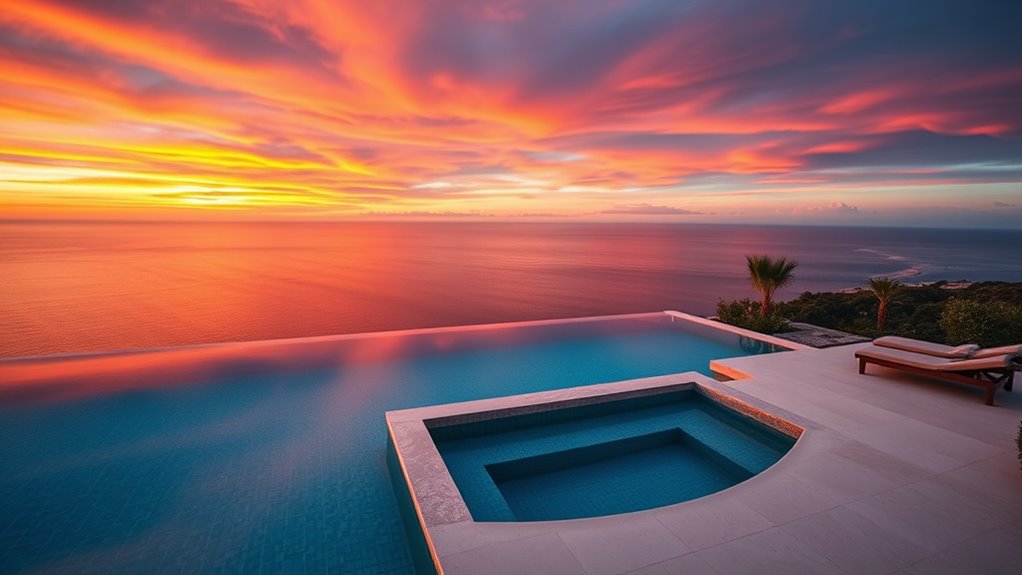
When it comes to visual impact and design aesthetics, infinity pools often create a striking, seamless appearance that blends the pool water with the surrounding landscape or horizon. This design gives the illusion that the water extends infinitely, adding a luxurious, modern touch to any property. The clean, sleek lines and the disappearing edge make infinity pools perfect for scenic locations or areas with stunning views. In contrast, plunge pools tend to prioritize a compact, functional look, often featuring simple shapes and visible edges. They offer a more subdued aesthetic, focusing on practicality rather than dramatic visual effects. If your goal is to make a bold, eye-catching statement, an infinity pool delivers unmatched elegance, while a plunge pool provides a more understated, cozy vibe. Additionally, the choice of pool type can influence the overall visual impact and ambiance, aligning with your specific aesthetic preferences and outdoor space style.
Assessing Space Requirements and Layout Considerations
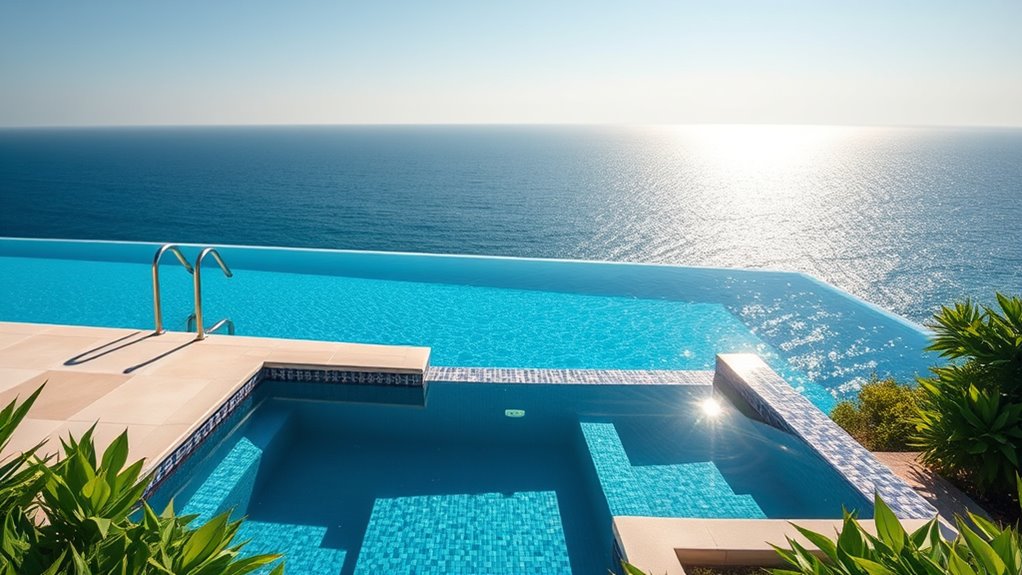
When planning your pool, you need to consider how much space each type requires and how it fits into your layout. Think about layout flexibility—can the pool be positioned easily, and does it allow for convenient access? Evaluating these factors helps ensure your pool complements your space and meets your needs effectively. Additionally, understanding zoning laws is crucial to ensure your pool installation complies with local regulations and permits.
Space Efficiency Comparison
While both infinity pools and plunge pools require designated space, their layout considerations differ considerably. Infinity pools often demand larger footprints to accommodate their expansive edges and seamless vanishing look. In contrast, plunge pools are more compact, fitting into smaller yards or tight spaces. Your choice depends on available area and desired visual impact. Additionally, the cost of installation varies significantly between the two options, influencing your overall planning. Here’s a quick comparison:
| Aspect | Infinity Pool | Plunge Pool |
|---|---|---|
| Space Needed | Larger, with room for overflow edges | Smaller, suited for tight spots |
| Layout Flexibility | Less flexible, needs open space | More adaptable to compact areas |
| Design Focus | Visual openness and grandeur | Intimate, cozy setting |
Layout Flexibility Factors
Understanding the space requirements and layout considerations for infinity and plunge pools helps you determine which option fits best in your landscape. Infinity pools often need more room due to their expansive edges and seamless design, making them suitable for larger, open areas. They require careful planning to accommodate their length and edge features without crowding other backyard elements. Conversely, plunge pools are compact and adaptable, fitting into smaller spaces or tight corners, offering greater flexibility in layout. Their simple shape allows for creative positioning, whether as a standalone feature or integrated into a patio design. Additionally, consider the aesthetic appeal of each pool type and how it complements your overall landscape design to create a cohesive outdoor space. Consider how each pool type interacts with your landscape, existing structures, and surrounding features to guarantee a harmonious, functional layout that maximizes your space.
Placement and Accessibility
Choosing the right placement for your infinity or plunge pool depends on evaluating the available space and how accessible you want it to be. You need to consider the layout of your yard or patio, ensuring there’s enough room for installation and maintenance. Infinity pools often require a prominent location with a view, so position them where they’re visible and unobstructed. Plunge pools are more flexible; they fit into smaller or tighter spaces, making accessibility straightforward. Think about proximity to your home’s entrances, privacy, and ease of use. If you plan frequent use, place the pool where it’s easily reachable without navigating obstacles. Proper placement enhances convenience and safety while ensuring the pool complements your outdoor design. Additionally, considering hydrogen safety protocols can be important if your pool area uses hydrogen-powered equipment or systems.
Cost Factors: Installation and Maintenance Expenses
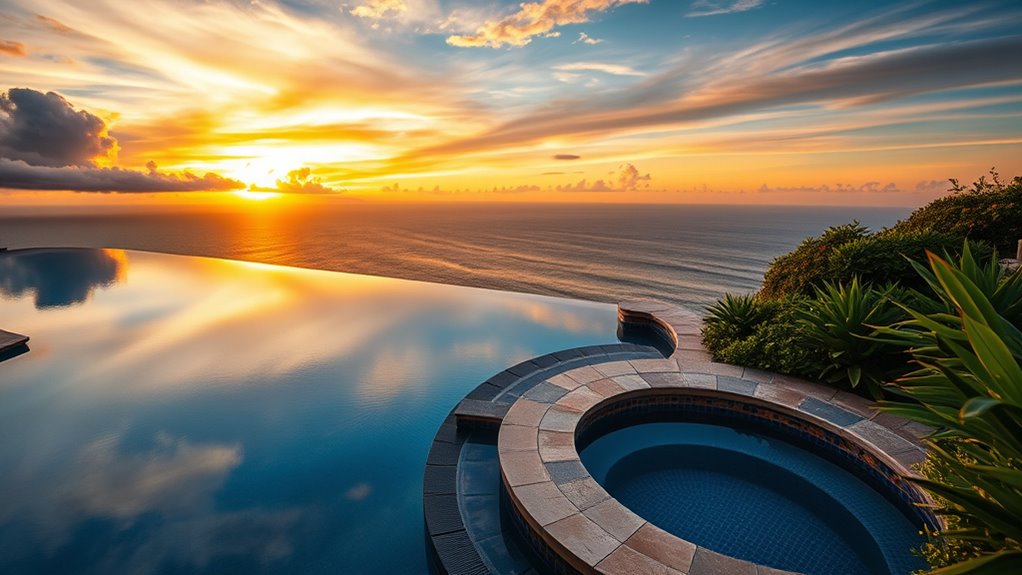
Installation and maintenance costs can considerably impact your overall investment in an infinity pool versus a plunge pool. Infinity pools typically require more complex construction, including specialized excavation, reinforced structures, and advanced filtration systems. This increases upfront installation expenses. Maintenance costs also tend to be higher due to the need for regular cleaning, water balancing, and equipment upkeep, especially since the open-edge design can lead to water evaporation and debris accumulation. On the other hand, plunge pools are simpler to install and generally involve lower ongoing maintenance costs because of their smaller size and less intricate plumbing. If budget is a concern, you’ll find that a plunge pool offers a more economical option over time, while an infinity pool demands a larger initial investment with higher ongoing expenses. Additionally, security vulnerabilities associated with advanced systems can lead to unexpected costs if not properly managed.
Ideal Settings and Landscaping Compatibility
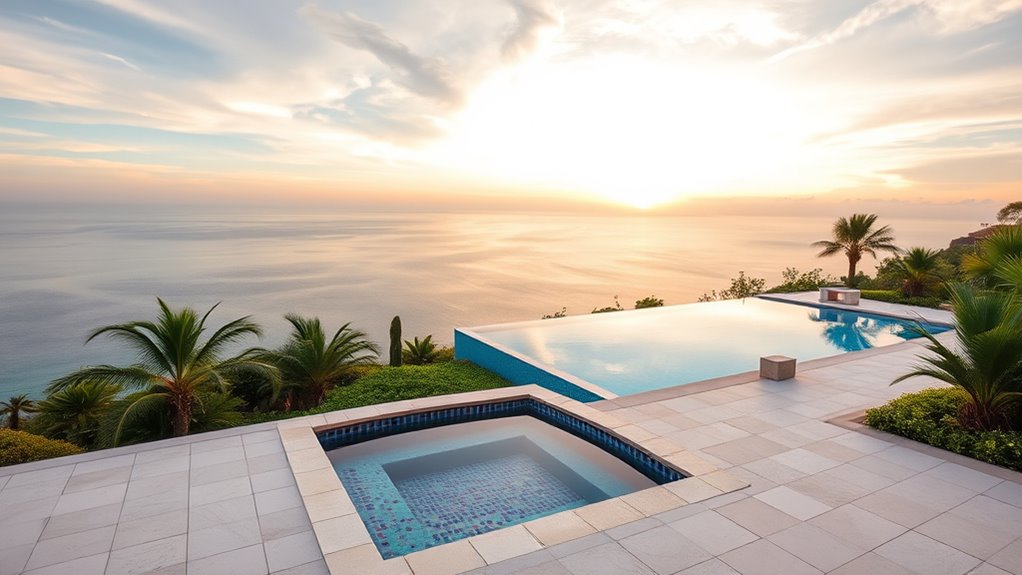
The setting and landscape surrounding your pool play a significant role in determining whether an infinity pool or a plunge pool fits best. If your property features dramatic views or a hillside, an infinity pool enhances the scenery with its seamless edge, creating a luxurious, panoramic effect. It works well in modern or minimalist landscapes where sleek lines complement the environment. Conversely, a plunge pool suits more intimate, landscaped yards with lush greenery or decorative features, blending seamlessly into a cozy outdoor space. Its compact size allows for creative landscaping, including privacy screens, deck areas, or tropical plants. Consider your property’s natural terrain and existing features when choosing, ensuring your pool complements and enhances your overall landscape aesthetic. Additionally, the water features and surroundings of nearby attractions like water parks can influence your pool choice by inspiring a specific aesthetic or vibe that matches your outdoor space.
Usage and Functionality for Different Lifestyles
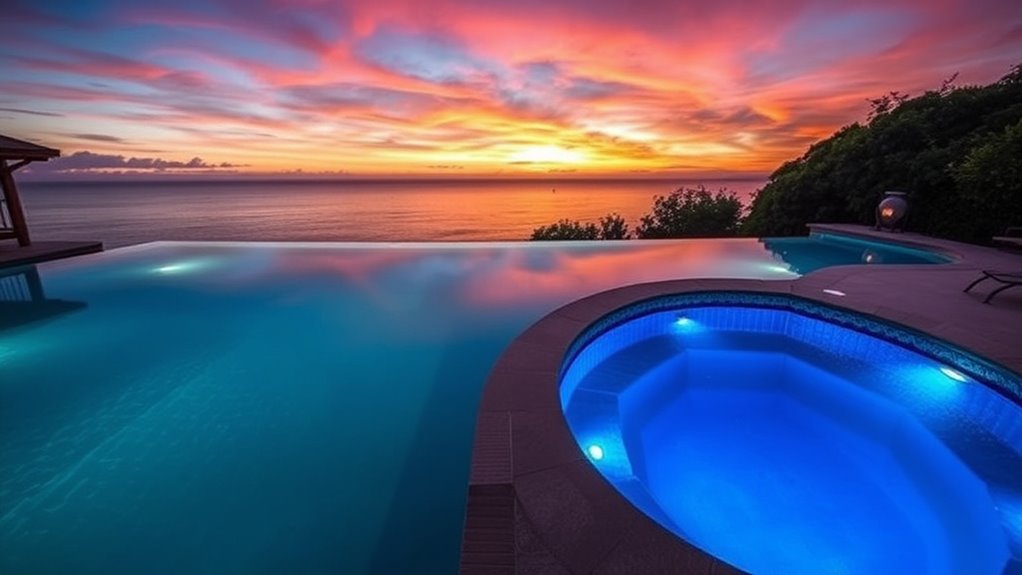
Your lifestyle influences how you’ll use your pool daily. If you love family fun and relaxation, a plunge pool offers quick dips and easy maintenance. For fitness and exercise, an infinity pool provides a spacious setting for swimming laps or water workouts. Additionally, consider space‑saving designs that maximize your available area while maintaining style and functionality.
Family Fun and Relaxation
When choosing between an infinity pool and a plunge pool for family fun and relaxation, it’s paramount to take into account how each option fits your lifestyle. An infinity pool offers a luxurious, expansive space where everyone can enjoy swimming and lounging together, fostering a sense of openness and connection. A plunge pool, on the other hand, provides a cozy spot for cooling off and relaxing without taking up much space, making it ideal for smaller families or those seeking quick refreshment. Consider how your family uses the pool regularly and what activities matter most. Additionally, understanding the sound healing science behind calming environments can help you create a more relaxing and harmonious poolside experience.
Fitness and Exercise Options
Choosing the right pool can markedly impact your fitness routine and how you incorporate exercise into your lifestyle. An infinity pool offers a luxurious setting for low-impact activities like water walking or gentle resistance exercises, making it ideal for relaxation and rehab. Its expansive design also allows for swimming laps, helping improve cardiovascular health. A plunge pool, on the other hand, is perfect for quick, intense workouts like HIIT or aqua aerobics due to its smaller size and deeper depth. It encourages short, vigorous sessions that boost strength and endurance. Both pools support different fitness goals—an infinity pool suits those wanting a mix of leisure and light exercise, while a plunge pool caters to high-intensity routines. Choosing a high-quality projector can enhance your viewing experience and make your fitness routines more engaging. Select based on your fitness preferences, space, and how you want to stay active.
Safety Features and Practical Considerations
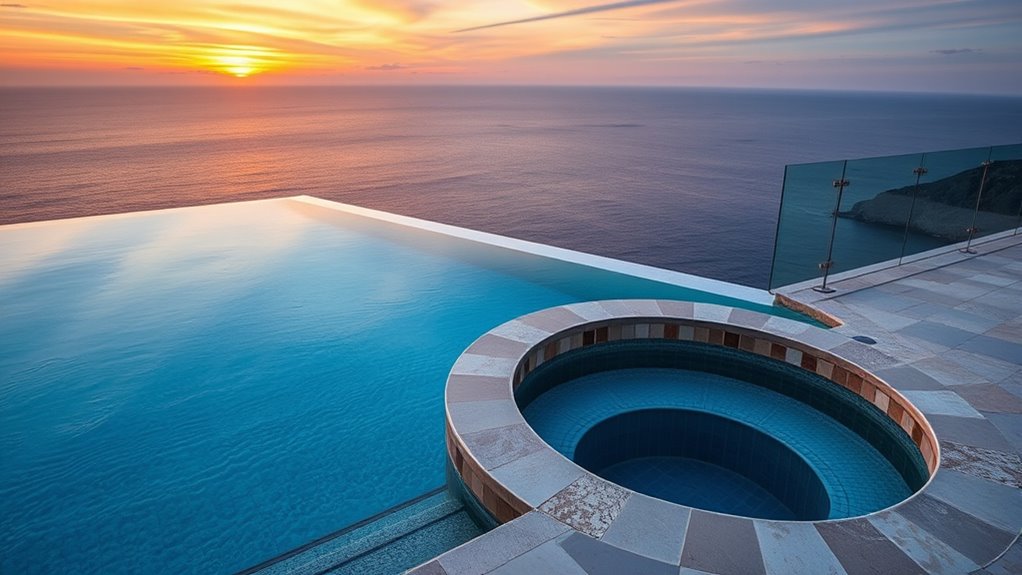
While both infinity pools and plunge pools can enhance your outdoor space, safety features and practical considerations are essential factors to keep in mind. You need to assess your space, accessibility, and maintenance needs to ensure a safe and functional setup. For example, infinity pools often require sturdy barriers or fencing due to their open edges, especially if you have children or pets. Plunge pools, being smaller, typically pose fewer safety concerns but still demand secure covers or alarms. Consider the following:
- Adequate fencing and barriers to prevent accidents
- Non-slip surfaces around the pool area
- Easy access points and steps for safe entry and exit
- Regular maintenance for water quality and structural integrity
These steps help you enjoy your pool safely and practically.
Enhancing Your Outdoor Environment With the Right Choice
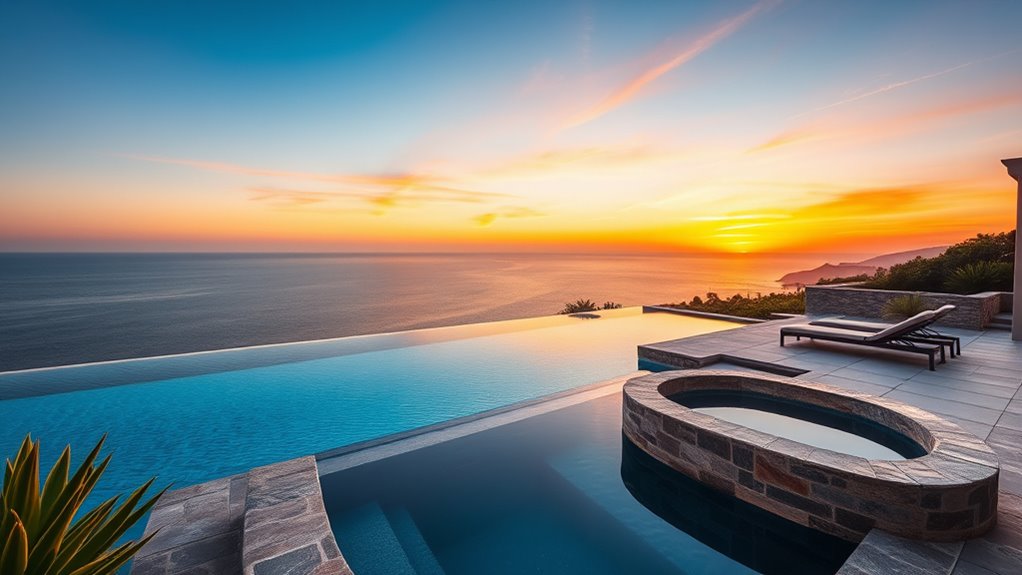
Selecting the right pool type can considerably elevate your outdoor space, creating an inviting area for relaxation and entertainment. An infinity pool offers a sleek, modern look that seamlessly blends with the horizon, enhancing views and adding a luxurious vibe. It encourages a calming atmosphere, perfect for unwinding after a long day. On the other hand, a plunge pool is more compact and versatile, fitting into smaller yards while providing a revitalizing escape. Its intimate size makes it ideal for socializing or cooling off quickly. When choosing, consider your outdoor layout, desired ambiance, and how you’ll use the space. The right pool type not only complements your landscape but also amplifies your outdoor experience, transforming your yard into a personal retreat.
Frequently Asked Questions
Which Pool Type Offers Better Energy Efficiency Over Time?
You’ll find that plunge pools tend to be more energy-efficient over time because they require less water to heat and maintain. Their smaller size means they use less energy for filtration and heating, saving you money on ongoing costs. Infinity pools, while stunning, often need more powerful pumps and heating systems, which can increase energy use. So, if energy efficiency is your goal, a plunge pool is the smarter choice.
How Do Local Climate Conditions Influence Pool Choice?
Your local climate greatly impacts your pool choice. If you live in a warm, sunny area, an infinity pool can be perfect, offering endless views and a luxurious vibe. In cooler or unpredictable climates, a plunge pool might be better, as it heats up faster and requires less maintenance. Consider your seasonal weather patterns and how often you’ll use the pool to make the best decision.
Are There Specific Building Codes for Installing These Pools?
Did you know that over 60% of homeowners face local building codes when installing pools? Yes, there are specific regulations you need to follow, including safety barriers, fencing, and electrical wiring standards. You should consult your local building department before starting construction. These codes guarantee safety and compliance, preventing costly fines or modifications later. Always hire a licensed professional familiar with your area’s requirements to streamline the process and avoid surprises.
How Do Maintenance Needs Differ Between the Two Pool Types?
You’ll find that infinity pools generally require more maintenance because they have complex features like overflow edges, which need regular cleaning and careful water level management. Their large size and advanced filtration systems also demand more frequent filter checks. Plunge pools, being smaller and simpler, need less upkeep, with easier cleaning and fewer system checks. Overall, your maintenance effort depends on pool size, features, and usage frequency.
What Are the Long-Term Resale Value Implications?
Think of your pool as an investment flower; its long-term resale value blooms depending on appeal. Infinity pools often boost property value due to their luxurious vibe, attracting high-end buyers. Plunge pools appeal for their practicality and lower maintenance, which can also entice value-conscious buyers. Ultimately, your choice influences resale prospects—an infinity pool may offer a more striking edge, but a well-maintained plunge pool can also be a strong selling point.
Conclusion
Choosing between an infinity pool and a plunge pool depends on your space, budget, and lifestyle. Did you know that plunge pools are up to 50% more affordable to install and maintain? Whether you want a stunning visual centerpiece or a invigorating escape, selecting the right pool enhances your outdoor vibe. Make your choice wisely, and you’ll enjoy a luxurious, functional retreat tailored to your needs for years to come.

